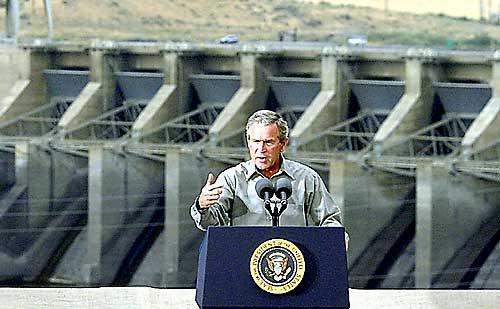forum
library
tutorial
contact

Updated EIS Sought
for Columbia River Dams
by Keith Kinnaird
Bonner County Daily Bee, October 2, 2016
|
the film forum library tutorial contact |

|
Updated EIS Sought
by Keith Kinnaird
|
 PRIEST RIVER -- Government agencies are preparing an updated environmental impact statement on the system operation and maintenance of 14 dams in the interior Columbia River basin.
PRIEST RIVER -- Government agencies are preparing an updated environmental impact statement on the system operation and maintenance of 14 dams in the interior Columbia River basin.
The analysis will include the Albeni Falls Dam on the Pend Oreille River and Libby Dam on the Kootenai River. The U.S. Army Corps of Engineers, Bonneville Power Administration and the Bureau of Reclamation are conducting to the review under the National Environmental Policy Act.
The agencies intend to use the EIS process to assess and update their approach for longterm systems operation and configuration through the analysis of operational alternatives and evaluation of potential effects to human and natural environments, including effects to socioeconomics and species listed under the federal Endangered Species Act.
"You can see that this is a massive undertaking," A. Scott Lawrence, a corps spokesman, said during a recent Albeni Falls operations update in Sandpoint.
The agencies will be hosting 15 public scoping meetings this fall and winter, two of which be held in the Panhandle.
One meeting is set for Wednesday, Oct. 26, in Priest River. It starts at 4 p.m. at the Priest River Event Center on U.S. Highway 2. The other is set for Thursday, Oct. 27, in Bonners Ferry. It starts at 4 p.m. at the Kootenai River Inn.
For those unable to participate, the agencies will be hosting an online webinar on Tuesday, Dec. 13. Instructions on how to participate can be found online (www.crso.info).
The deadline to submit written comments on the EIS is Jan. 17, 2017. However, the agencies will requests for comment period extensions if they are received no later than Dec. 1, according to a notice of intent to prepare the EIS.
Lawrence said the EIS will contemplate dam removal on the Snake River, although there are no removal plans on the Columbia.
The updated EIS will also consider the effects of climate change, such as warmer water temperatures, diminished snowpack and altered flows. The EIS will also identify measures to avoid, offset or minimize impacts to resources by system operations where feasible.
Written comments are to be directed to the U.S. Army Corps of Engineers Northwest Division, Attn: CRSO EIS, P.O. Box 2879, Portland, OR. 97208-2870. Submit online comments to comment@crso.info. For further information, call 800-290-5033 or visit www.crso.info.
Sockeye recovery plan completed in 2015Last year, NOAA Fisheries completed a recovery plan for sockeye salmon, which used to return in great numbers to Redfish Lake and other lakes north of Ketchum. NOAA's Interior Columbia Technical Recovery Team proposed biological viability criteria that must be met before Snake River sockeye salmon can be delisted from "endangered" status. NOAA reports that a minimum of 1,000 wild spawners must be achieved in both Redfish Lake and Alturas Lake. The minimum spawning abundance threshold for Pettit, Stanley or Yellowbelly lakes is 500 wild spawners. This year, a total of 574 sockeye salmon returned from the ocean to the Sawtooth Valley. Of those, 329 continued into Redfish Lake to spawn, while Idaho Fish and Game brought the other 245 into their hatchery program to spawn in captivity and produce more captive-raised fish. In addition to those fish returning from the ocean, Idaho Fish and Game released 786 captive-reared fish into Redfish Lake to spawn, and another 100 fish into Pettit Lake to spawn there. "The benchmark of 1,000 returning fish cited in the recovery plan refers to fish returning from the ocean, so the captive-reared fish do not count toward that total," said NOAA Fisheries spokesman Michael Millstein.
Idaho Mountain Express, by Tony Evans November 2, 2016
learn more on topics covered in the film
see the video
read the script
learn the songs
discussion forum
